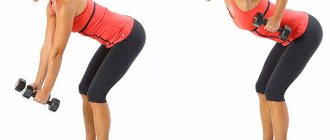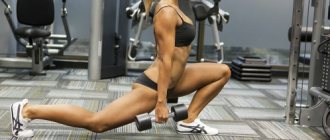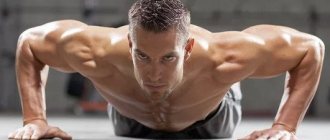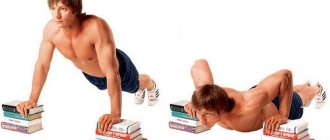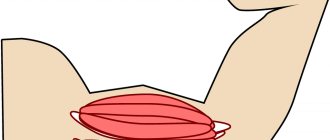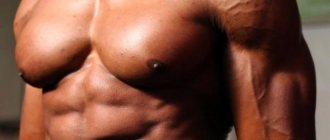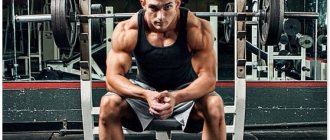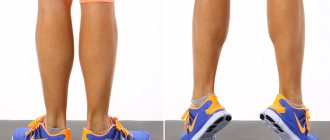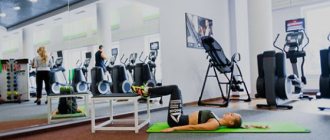What are the benefits of forearm and hand exercises?
Many athletes, intensively working their triceps and biceps, do not pay enough attention to their wrists and forearms. Remaining undeveloped, they prevent the athlete from realizing his full potential. Thanks to the forearms and wrists, the most effective exercises are carried out on the deltoids, biceps, triceps, back, and chest. They must be strengthened and become part of every training.
Complaints regarding weak and thin arms are primarily associated with a lack of proper attention to this part of the upper body. This also applies to the legs, by the way. If they are not developed, they remain underdeveloped. Changing the position allows you to constantly work on your hands. It is necessary to perform wrist exercises regularly, and then even weak and undeveloped wrists and forearms will become stronger
Basic Exercises to Strengthen the Wrists and Forearms
There are seven effective, fairly easy-to-do exercises that will allow you to forget about weak arms. It is recommended to do this complex three times a week. The main thing is that it is performed on a regular basis.
"Warm-up"
The following exercises will prepare you for more intense and difficult ones. They will warm up and prepare your wrists for further more complex work.
- Curl the fingers of both hands into fists. Hold this position for half a minute and open your palms. Repeat flexion and extension twice a minute.
- Bend your wrists for 30 seconds and then straighten. You can't bend your elbows. They must remain straight at all times.
- Extend your arms in front of you and pull your wrist forward, raise your palms up, hold the position for 30 seconds, return to the starting position. Repeat at least 4 times, for a total of 2 minutes.
"Intense"
Once your hands are warmed up, proceed to the remaining four exercises:
- Arm bending. Take a sitting position, straighten your back. Take a light dumbbell and place your hand on the top of your leg so that it rests on your thigh. Raise and then lower the clamped weight. Perform 3 sets of 20 repetitions each. This exercise perfectly develops the brachioradialis muscles.
- flexion . Performed from a position similar to the previous one. To maintain balance, the hand is placed exactly on the thigh. The wrist with the dumbbell is raised and lowered. Do at least 3 sets of 20 reps each.
- Reverse (reverse) wrist flexion. Sit with a dumbbell in your hand, straighten your wrist and then bend it. Make sure your palm is facing down and your elbows are in line with your hips. Perform 3 sets of 20 curls.
- Flexion of fingers. A simple, but excellent exercise for developing the muscles of the arms and fingers. Take a dumbbell and place your hand on your thigh with the back of it facing up. At the same time as you lift the dumbbell, squeeze and relax your fingers as you lower it. Choose a weight that is as comfortable and easy to lift as possible.
Wrist curl
This exercise tells us how to pump up the wrist and inner forearm. The exercise is formative. Increases volume and strength of the inner forearm.
Execution technique
- Take dumbbells in your hands and kneel in front of the bench. Place your forearms across the bench so that the palms of your hands face up. Extend your wrists beyond the edge of the bench (the dumbbells should not touch the bench as you extend them). Move slightly away from the bench so that your arms are almost straight. The torso and forearms should remain motionless throughout the exercise. The dumbbells do not need to be squeezed tightly in your hand; it is better to make your grip a little weaker so that the dumbbells seem to “roll” between your fingers.
- Straighten your wrists completely and then gradually lower the dumbbells down.
- Try to lift the dumbbells as high as possible, but perform the movements smoothly, while tightening the muscles of the forearm. Under no circumstances lift your elbows and forearms off the bench.
- How to pump up your wrists ? The hands should be positioned 60 degrees above the horizontal at the top of the exercise. Having reached the top point, you can fully extend your wrists and smoothly lower the dumbbells.
- If you are using heavy dumbbells for the exercise, remember to be sure to hold your breath while lifting. Exhale when the dumbbells are already lowered.
Adviсe
- In the starting position, your arms must be straight. To achieve maximum muscle contraction, it is necessary that their ligaments be extremely stretched. And when you extend your elbow joint, all the flexor muscle ligaments are stretched. This is how we ensure the maximum effect of the exercise.
- It is strictly forbidden to lift your elbows and forearms from the bench. If this does happen, then most of the load goes to the biceps, instead of providing tension to the forearm muscles.
- To increase the range of motion, we need to slightly relax our fingers and hold the dumbbells with a kind of loose grip. When you grip the dumbbells tightly, you lose the ability to fully extend your wrists.
- How to pump up your wrists correctly? As you lower the dumbbells, you will notice that your wrists may rotate outward slightly, causing your little fingers to spread apart. Don't think that this is in any way injuring your wrists; on the contrary, it allows them to extend much more. Additionally, when you try to keep your wrist still, you risk injuring it. Therefore, it is better to perform wrist curls with dumbbells (both safer and more effective) rather than with a barbell, which does not allow the wrists to rotate outward.
Application
Intended for: Everyone from beginners to professionals.
When: To start your workout, perform barbell curls with a reverse or hammer grip, and then move on to wrist curls (after you've completed all the biceps exercises).
How much: 2-4 sets of 14-16 reps
Sports instruction: Wrist curls focus all the stress on the muscles of the inner forearm. This part determines the volume of the forearm (this is especially noticeable when you raise your arms or turn your palms outward).
This exercise is usually used to eliminate an imbalance in the growth of the muscles of the forearm and biceps, because when the forearms are small, even beautiful, voluminous triceps and biceps will not decorate your arms.
Wrist curls are a great exercise that can help you excel in volleyball, tennis, wrestling, and basketball by developing a strong grip.
How and why to pump your hands?
Not everyone understands how and why it is necessary to pump up the hands, because when we mention the hands, we first of all think about the biceps and triceps. As a result, the training process does not affect the wrists; they become a lagging muscle group and slow down progress, preventing the hands from being fully trained. Strong hands mean a strong grip; it is needed both for bodyweight training and for working with weights. From this material you will learn what grip strength depends on and how to develop it.
Your palms are one of the most complex systems in the body; even in traumatology they are classified as a separate group. The hand is made up of three sections: fingers, metacarpus and wrists. The structure of the wrist includes eight bones, the metacarpus has five bones, as do the fingers. Each of the fingers has three phalanges, with the exception of the thumbs, which have two phalanges.
This entire structure is set in motion by muscles, they are located on the side of the palm, they are divided into the muscles of the little finger, middle finger and thumb. The fingers do not move on their own, as it may seem; most of the muscles that move them are located in the forearm. These muscles are connected to each finger by tendons.
How to pump up a girl's arms with dumbbells?
The advantage of dumbbells is the ability to use them at home. In order to quickly pump up your arms at home, it would be a good idea to purchase dumbbells at a sporting goods store, because sets of exercises with dumbbells work each part of an individual muscle in the most isolated way. Particularly for the arms, there are a large variety of exercises.
Bicep Curls
Biceps curls are a very versatile exercise and have many grip variations and amplitude variations, and the load on this muscle directly depends on the position of the body when performing a particular exercise.
As a rule, there are three main grip options when performing this exercise:
- Palm up grip;
- Palm inward grip (hammer);
- Reverse grip, palm down;
To change the dynamics of the load, you can choose the position of the body before performing the exercise. Variations of body positions:
- Sitting;
- Standing.
The number of grips provides only the basis of the technique, and to improve results, you can use a non-standard exercise technique, depending on the specific grip. This exercise is good for girls and will help pump up a girl’s biceps.
Standard technique when using a palm up grip. To perform this exercise, you should choose a body position, standing or sitting. When sitting, you can concentrate more on technique and effectively work your biceps. When standing, stabilizer muscles are more involved. There is also such a position as sitting on an inclined bench, leaning your back on the raised backrest; in this option, the biceps are most stretched and during repetitions, a greater percentage of blood is pumped into the muscle fibers. So, you have chosen the position of the body; to continue, you should select the optimal weight of dumbbells. Next, you should take a dumbbell in your hand and perform a biceps lift, firmly fixing the elbow parallel to the body, the lift should be carried out so that the bending at the peak point is 10-15% higher than the right angle, and you should lower it without straightening the arm completely by 10-15 %. This technique for performing all types of biceps curls is universal.
Non-standard technique when using a palm-up grip. Here, when lifting the dumbbells to the peak point, you should specifically turn the hand down, so as to increase the load on the biceps. The position of the hand below should be such that the little finger is slightly higher than the thumb. The technique is similar.
When performing the exercise with a reverse grip, you can also use a non-standard technique. To do this, rotate the brush slightly, about 40-45 degrees outward. Such a change in the position of the hand will add stress to the forearms. Approaches to this exercise should be done 3-4, each with 8-12 repetitions.
Such interesting variations will definitely give results.
Overhead dumbbell extensions
This exercise is focused on the triceps and is quite optimal for a woman or girl. The exercise is quite interesting and has three grips:
- Palms inward;
- Palms up;
- Palms down.
There are also two types of body position:
- standing;
- Sitting.
The ability to choose grips and body position gives a load on all heads of the triceps and loads the triceps separately or increases the load on the stabilizer muscles.
The exercises should be performed in this way: select a body position, then take dumbbells, select a grip and place your arms straight behind your head until your arms form a straight line in relation to your body, bend and straighten your arms.
Important! When performing this exercise, you need to keep your elbows as close to each other as possible and fix the shoulder joint. You need to extend and bend your arms without reaching the extreme points of the amplitude by 10-15%. Do 8-12 repetitions, 3-4 sets.
Bent over arm extensions
This exercise also targets the triceps muscle and promotes its good development. Performed with dumbbells and on a bench. Combines three grips:
- Palms inward;
- Palms up;
- Palms down.
When performing this exercise, the body position is not selected, but there is still a variation in grips. To perform this exercise, you should kneel on the bench, rest your other foot on the floor, place one hand on the bench, and take a dumbbell with the other. Next, raise the hand with the dumbbell to the level of the lower back and fix the elbow at its level. Extension and flexion should be done at partial amplitude, not reaching 10-15% at the end points. The number of repetitions is 8-12, sets 3-4. How many kilograms to choose dumbbells is selected individually.
Hammer with dumbbells
Like all of the above exercises, you can perform them at home and successfully pump up your arms. This exercise targets the outer head of the biceps, brachialis, and forearm. The grip in this exercise is usually one - palms inward, but there are two body positions:
- Sitting;
- Standing.
Variants of body positions provide a varied load; when performing the exercise while standing, additional stabilizer muscles are involved, and in a sitting position, you can concentrate the load on the biceps. Also, if you have a bench with a back, you can perform it with excessive stretching of the biceps, thereby increasing overall efficiency. The technique for performing the exercise is the same as for the classic dumbbell curl.
Interesting fact! When changing the technique of performing such an exercise, namely bending the arm in front of you, bringing the amplitude of the lift to the shoulder, the brachialis is activated.
Why download brushes?
A beautiful and strong body should be developed evenly. If you only train your legs or abs, the result will not be as you would like. You need to remember even the smallest muscles, because they can play an important role in athletic development. Grip strength is important in most training programs, especially if you are wrestling or lifting weights. It may seem that bodybuilders do not care about grip strength, because they are focused solely on muscle volume and spectacular appearance. But with a weak grip, they won't be able to lift heavy weights to achieve that look.
What is the grip like?
Before you start pumping your hands at home, you need to understand how they work. They provide several types of force:
- squeezing - used when shaking hands; an expander would be a good trainer for its development;
- plucking - thanks to it we can hold objects between the index finger and thumb, it is also often called thumb strength;
- holding - allows you to hold something in your hands for a certain period. In training, you use this force when you do stiff-legged deadlifts and similar actions;
- wrist - try to hold a fairly large object on an outstretched arm, if you succeed, then only thanks to this strength. It builds the strength of the entire forearm.
Hand training exercises for girls at home
To pump up a girl’s arms at home, there are many exercises and sports programs that are suitable for any level of physical fitness. Below we will provide you with a list of the most effective and suitable exercises for the female body for developing arm muscles:
- Dumbbell curls or dumbbell biceps curls;
- Hammer exercise for biceps with dumbbells;
- Biceps curls with expander;
- Extension of arms with dumbbells from behind the head;
- Bent over arm extension with dumbbells;
- Push-ups from the knees, narrow grip;
- Reverse push-ups from a support;
- Pull-ups on the horizontal bar using an expander.
It is important to know! In order to pump up a girl’s arms and achieve the desired volumes, as well as definition, you must follow the dogmas, following which will lead you to success:
- Proper nutrition;
- Sufficient time for sleep and rest;
- Rejection of bad habits;
- Correct technique for performing exercises;
- A well-designed sports program, taking into account the individual characteristics of the body.
The sports program is usually divided into exercises for sculpted arms and exercises for building volume. It is worth remembering that proper warm-up before training will protect your body from unwanted injuries.
Best exercises
Rotations
The movement is used as a joint warm-up before exercise. Clench your fists and rotate them intensively, making the rotation amplitude maximum. Rotate your fists in one direction for a minute, then the same amount in the other direction. After that, feel free to move on to the next elements.
Compression
A simple yet effective movement that requires no equipment and is therefore ideal for home use. Clench your fists forcefully and hold maximum tension for a few moments, then straighten your palm and immediately repeat. Do two approaches for a couple of minutes with a pause between them for complete relaxation.
Pressure
Place your palms at chest level, press them together to create a strong static tension over the entire area, from the base of the palm to the tips of the fingers.
Maintain the tension for two minutes, then rest for a minute and repeat two more times.
One-sided pressure
Leave your hands in the same position and work with each palm separately, pressing it forcefully into the second one so that it leans back. Alternate exposure for 5 seconds on each side, do five to ten cycles in a row.
Leads
The starting position is the same, without lifting your palms from each other, alternately pull your fingers back strongly so that they arch. Performed at a fairly high pace, 20-30 repetitions in three approaches. Focus on tension and relaxation of muscles, including those in your forearms.
Squeezing with fingers
Place your thumb and index finger on each hand so that they touch the pads. Squeeze them tightly, maintain the tension for a few moments, then repeat the same not with the index finger, but with the middle one, and so on in order, then in reverse order. Performed in at least five circles.
Flexion and extension without weights
Place your forearms parallel and clench your fists. Bend your wrists inward, then extend outward as far as possible. The amplitude should be full, execution should last a couple of minutes without pauses.
Ball Squeeze
It is not necessary to use a special expander ball; an ordinary tennis ball or any other ball of the same size will do. Grab it tightly and squeeze for five seconds, then relax and repeat, do 5-10 repetitions. It is better to perform the action not with two balls, but alternately with one, then you will be able to better concentrate on the sensations.
Holding an item
You will need a flat but weighty object, for example, a small barbell plate. Lift it into the air and hold it for as long as you can, then lower it, rest a little and repeat 3-4 more times. With each execution, the muscles must be loaded to failure.
Push-ups on fingers
With this type of push-up, the muscles we are interested in will receive maximum load, since the entire body weight will act as resistance. It is better to take a position in which your feet rest on the floor not with your toes, but with your knees. The muscles of the hand will get tired faster than larger ones; in this case, you should focus on them and perform them to failure.
Exercises
After warming up, you can move on to the main exercises.
Arm exercises with dumbbells
- Raising straight arms forward.
Starting position: feet shoulder-width apart, back straight, chest forward, shoulder blades pulled together, elbows slightly bent.
Alternately, as you inhale, raise your straight arms forward to the chest line, and while exhaling, lower them to the starting position. During the exercise, do not raise your shoulders and do not lean your hand forward. Raising dumbbells in front of you gives relief to the front deltoids, that is, this will pump up your upper arms.
The following two exercises are the most effective for training your arms at home. If performed regularly at home, the first results will appear no later than 2 weeks.
- Biceps curl.
Lowering your straight arms with dumbbells down, press your elbows to your body and alternately bend your arms at the elbows, lifting your hand from the dumbbells to your shoulder. If we are working with a tape expander, then we perform the exercise of bringing the hand to the shoulder by standing in the middle of the tape and holding its edges in the hands. In the lower position, do not fully extend the elbow.
The exercise is often called a “hammer” or “hammer curl” and is performed with a neutral grip (when the back of the hand is turned outward in the starting position) or an underhand grip (when the palm faces the ceiling when lifting). Often, starting with a neutral grip, at the top point, at shoulder level, supination is performed (slightly turning the hand toward you).
The dumbbell biceps curl has many variations. Can be performed:
- with both hands at the same time;
- alternately, i.e. first only the right one, then only the left one;
- alternately: once with the right, once with the left.
From a standing, sitting, lying position.
When performing the exercise, it is important not to lean towards the working arm and firmly fix your wrists, do not throw the dumbbells. To pump up your arm muscles and avoid injury, you need to make smooth movements.
- Overhead press.
This is a triceps exercise. But depending on the execution options, it allows you to train other muscles.
- Raise both arms with dumbbells up, elbows slightly bent and looking forward. Bend your elbows, lowering your forearms back until they touch your biceps. As you exhale, we return to the original vertical position.
You can hold your hands parallel, squeezing one dumbbell in each, or you can connect your hands, working with one dumbbell as in the picture. Also, to change the load vector, perform the exercise “French dumbbell press” - performed lying down. Details of the implementation can be found in the article.
You can use the barbell with a palms-forward grip, the distance between the hands is about 10 cm.
If a rubber or spring expander is selected, then the upper row is performed, for example, from the “scissors” position, when one leg is pulled back and holds the end of the expander, the other end of the elastic band is clamped in the working hand. The trajectory of the forearm movement is the same as when working with a dumbbell.
- With your arms raised up, if in the initial position they are parallel, you can bend your elbows, tilting your forearms with a small amplitude to the right and left.
- Another triceps exercise allows you to work your upper biceps at the same time. We bend our knees, tilt our body a little forward, and move our straight arms down and back, so that our elbows look at the ceiling. We bend the elbows towards the shoulder, and then return the forearm to its original position. In this exercise, only the forearm works, the upper part of the arm from the shoulder to the elbow is motionless in a backward position.
Triceps exercises can be performed standing or sitting.
- Wrist flexion and extension.
If the biceps and triceps are sufficiently pumped up, and the forearm looks disproportionate in comparison with them, which is unlikely in girls, you can train the forearm muscles separately after working on the biceps. The main exercise is flexion (underhand grip) and extension (overhand grip) of the arms at the wrists in a sitting position. Here is one possible exercise.
We take a sitting position, so that the knee of the supporting leg looks slightly toward the floor (this increases the load compared to a horizontally positioned knee), we place the elbow on the prepared leg, and take the dumbbell with an underhand grip, so that the palm looks exactly up.
We lower the weighted wrist as far back as possible and slowly bend it towards ourselves, the other hand is motionless. Only the forearm muscles work.
You can complicate the exercise by increasing the amplitude by lowering the dumbbell to an extremely low position, when it is held only on the bent fingers of the palm laid back. Then the fingers are gradually twisted and then the entire wrist is raised. This complication simultaneously strengthens the fingers and stretches the muscles and tendons of the forearm.
After 10 executions, we turn the hand 90 degrees, so that the fingers look to the side, and the dumbbell clamped in them is vertical, and with the maximum possible amplitude, we slowly bend and straighten the wrist up and down.
The hand should be relaxed, and the movement is carried out by the muscles of the forearm. After 10 repetitions, we again turn the hand 90 degrees, so that the closed fingers look at the floor, and repeat the flexion-extension movements 10 times.
It is important to tense your hand here; you can tilt your body to the side to fully load your forearm.
Parterre
Push-ups are the most popular bodyweight exercise.
- Push ups.
From a lying position, arms shoulder-width apart, bend your elbows, lowering your straight body to the floor. The lightweight version is performed from a lying position with support on the knees, hands parallel, fingers facing forward, abs tense.
You can do three springs (lower your chest to the floor three times and raise it without straightening your elbows to the end), and on the fourth count return to the starting position. Repeat 10 times.
- Reverse push-ups (dips).
We place our hands shoulder-width apart at the back, legs extended forward, you can bend your knees a little. Bend your arms until your elbows are parallel to the floor. We return to the starting position.
Exercises on the horizontal bar
- Hanging on the bar. The longer you hang, the better - it trains arm endurance and stretches the spine.
- Pull-up, overhand grip. First, you need to master 3-5 pull-ups, then increase the number to 10 times.
- Reverse grip pull-up.
Special exercises for hand training
- The most obvious way to pump up your fingers and hands is to train with an expander; choose the one you have at hand. It doesn’t matter whether it’s a “rubber donut” or “pliers”.
- Pull yourself up and hang on a large diameter pipe.
- Move your hands along the monkey bars. You can also make the task more difficult for yourself and perform the exercise with wet palms.
- For as long as you can, hang and pull yourself up holding onto a belt thrown over the horizontal bar.
- Lift a load tied to a stick. A rope should be attached to the center of the stick, the other end of the rope should be tied to the load. While turning this projectile in your hands, you need to gradually raise and lower this load
- Crumple a tennis ball.
- Crush plasticine or similar materials.
- Practice with a mace by hitting a car tire. At first, you can take it closer to the middle of the handle, moving towards its end as the hand develops. Alternately do the exercise both by grabbing the mace with both hands and holding it in one hand.
- You can also do the following exercise. Thread a thick fabric (such as a kimono) through the handle of the weights, then lift and manipulate it (right, left, diagonally, etc.) with different grips (all fingers, three fingers, from above, from the side, etc.).
- Raise and lower a load (dumbbell, light weight) tied to a belt, crumpling this belt first with one hand, then with the other.
- Lift the barbell with an overhand grip. To do this, stand straight, take the barbell in your hands with a straight grip, and as you exhale, lift it to the solar plexus, trying only to bend your elbows. It is also important to hold the projectile for a short time in the upper position. Be careful with this exercise and don’t rush to do it right away with heavy weights; it’s most convenient to do it with an empty bar at first. If performed incorrectly or with too much weight, you can injure your elbows.
- Do push-ups on your fingers. To begin with, you can do push-ups on all five, over time you can try to reduce it to three fingers.
The Best Arm Exercises for Women Without Dumbbells
There are often cases when it is not possible to buy dumbbells or make them yourself, the reasons may be different, but in these cases there are exercises for which dumbbells are not needed. Now we will answer your question “How to pump up a girl’s arms at home, without dumbbells. The muscle groups that are located in the arms can be affected by exercises with your own weight; below we will provide a short list of such exercises and consider the most suitable ones.
List of exercises without dumbbells:
- Push-ups from the floor, from the knees;
- Full push-ups from the floor (narrow, medium and wide hand placement);
- Reverse push-ups;
- Pull-ups on the horizontal bar (with and without an expander);
- Curling your arms with an expander for biceps.
Reverse push-ups
This exercise allows you to work the entire back of the arm, but is quite complex and has three types of execution, as well as options for setting the width of the arms.
To perform this exercise, you need to sit on a sofa, chair or bench. Next, you should rest your straight legs on the floor and, holding your weight on your arms, shift your torso so that your pelvis is above the floor. Next, you should lower your body on your arms without touching the floor with your pelvis and return to the starting position. To reduce the load, your legs can be bent at the knees, and to increase the load, your legs can be placed on a support and as close to you as possible. This way, you can maximally load the triceps. If the load is not enough, you can use weights.
Narrow push-ups (on knees)
This exercise uses a large number of muscles and allows you to pump not only the triceps, but also the pectoral muscles, shoulders (front delts), forearms, back muscles and abdominal muscles.
Technique for performing the exercise. To perform it correctly, you should kneel and place your hands on the floor, then perform a push-up. To increase the load, you can perform full push-ups, but this requires a good level of physical fitness, you can also use weighting in the form of special vests or a regular backpack, into which you can place various heavy objects. Perform in 3-4 approaches, 8-20 repetitions each.
Pull-ups with a narrow reverse grip (using an expander)
This exercise is technically difficult, but allows you to perfectly work the inner part of the biceps. To perform this exercise, you will need to purchase a horizontal bar and an expander.
Horizontal bars come in different types, and it’s up to you to choose which one to buy. Resistance bands are classified by the tension they generate in kilograms and significantly reduce or increase the load during exercise.
Technique for performing the exercise. You need to take an expander and secure it to the bar, then throw it over one of your knees, grab the horizontal bar with a reverse grip (palms facing you) and do a pull-up so that your chin is at the extreme point of the amplitude, slightly above the bar. The exercise should be performed for 2-3 approaches, 6-12 repetitions in each approach.
Biceps curls with expander
If you are going on a business trip or on vacation, naturally you will not want to take dumbbells with you, so you can get pumped up biceps with the help of an expander that you can take with you anywhere. To perform biceps curls, you need to take an expander from one end, put your leg through the other end of the expander and perform it using a technique similar to classic biceps curls with dumbbells. The main feature of the expander is that by folding it in half, you will increase the load. Perform the exercise in 3-4 approaches, 8-12 repetitions each.
Imitation-situational:
- Power wrestling wrist grab – the task is to grab the opponent’s wrists. being in a fighting stance and trying to hold them. In this case, you can use only the strength of your arms and work with your hand and fingers, without resorting to using your body weight, legs, etc. At the same time, the opponent tries to free himself from the grip in a similar way and grab your wrists. You can also practice with two opponents at the same time, with each hand fighting a different opponent.
- Lifting the boxing bag with the phalanges of the fingers. The point is to try to grab the bag with your phalanges of fingers from a fighting stance, as if “pinching” it, and try to lift it as high as possible.
- “Crocodile” - everything is simple here, you need to cling as tightly as possible to the kimono (or other combat suit) of your sparring partner. Your partner should drag you around the mats quite a bit, trying to shake you off. Your task is to hold on.
How to pump up your hands at home with dumbbells
Many people ask how to pump up their hands at home with dumbbells, what needs to be done for this, what exercises are available, techniques and training regimen.
After all, in sports, not only exercises are important, but also the correct technique for performing them and nutrition. In the article you will learn how to pump up your hands at home with dumbbells, what sets of exercises are available and how to perform them correctly to achieve the desired results. It is important to train according to the schedule, not to miss classes and to do all the exercises correctly. Find out: how to pump up your hands at home and on the horizontal bar.
How to pump up your hands at home with dumbbells
The first thing you need to pump up your hands at home with dumbbells is to set a big and worthwhile goal that will motivate you to train to the maximum, regularly and correctly. Write this goal on a piece of paper, set a clear date by which you need to achieve the goal and hang it in a visible place.
The second thing you need to pump up your hands at home with dumbbells is to draw up a clear tinting plan to reach your goal. In your training plan, write down clear exercises, sets, repetitions, technique and time. Work out according to the plan 3 times a week or more often, depending on your desire, but do not skip workouts. Find out: Increasing hand strength.
How to pump up your hands at home with dumbbells - exercises
To pump up your hands at home with dumbbells, perform these exercises regularly, do the right approaches and repetitions, and then everything will work out for you.
To pump up your hands at home with dumbbells, you first need to do light exercises for your hands to stretch them and not injure them. After this, you can safely begin basic exercises on your hands.
To pump up your hands at home with dumbbells, you just need to take dumbbells in your hands and do any lifts, biceps, triceps, shoulders. This will not only pump up your hands, but also other parts of your arms.
Hold dumbbells for a while
To pump up your hands at home with dumbbells, take dumbbells in your hands and hold them for a while, standing straight. It is advisable to hold for 5 to 10 minutes. To do this, select a sufficient weight of dumbbells or replace them with backpacks or water bottles.
Pushups
Also, to pump up your hands at home, do simple push-ups from the floor with a narrow, wide and regular grip. Increase the load gradually and everything will work out.
To pump up your hands, you need a regular expander that you can squeeze in your hand more than 10 times. This convenient exercise can be done anywhere, at school, at work or at home while watching TV. Find out: how to pump up a girl’s arms in the gym.
How to pump up your brush
First, let’s look at such an important point as preparing for the exercises, which will be discussed further. Warming up the hand is required in order to avoid unpleasant consequences: stretching and overload.
The essence of such a warm-up is the dynamic movement of the hands in different directions. But do not forget about the general warm-up of the body, since the exercises also involve other muscle groups.
So, how to pump up your hands with maximum results? The work is not difficult, but it requires persistence and, most importantly, systematicity.
We got ready for training. In search of an answer to how to pump up the muscles of the hand, “old friends” will help us, further down the list.
Horizontal bar
Pull-ups on the horizontal bar form a powerful grip. During exercise on the horizontal bar, the main load falls on the hands.
After a month or two, your hands will be transformed, and the visible result will appear in the aesthetic, attractive appearance of your hands. While doing pull-ups on the horizontal bar, keep your palms facing you.
The jump to the heights can be done at any speed, but the descent is better done slowly and while exhaling - muscle mass and endurance increase precisely in this phase of the exercise.
Push ups
Another great way to develop strength and make your arms look attractive.
But how to pump up your hand muscles without harming yourself? First of all, when doing push-ups on your fists, distribute the load on your index and middle fingers.
Do not under any circumstances place increased stress on the joints of the little finger and ring finger, as this can damage your vision. For example, in our army they know this well, but snipers are generally forbidden to do push-ups with their fists.
Expander
Pros: you can study without interruption from work.
Cons: complex training in the form of push-ups is much more effective, since it involves not only the muscles of the arms.
Next we will talk about how to pump up your hand while on vacation or at your grandmother’s in the village. If you have a boat, you can turn every exciting trip into a great workout. Rowing sports will make your arms stronger and more beautiful; you can also visit gyms that simulate rowing if you live in the city.
Grandma asked you to chop wood? Tell her a huge thank you! This exercise not only builds arm strength and endurance, but also makes the blow sharp and heavy. By the way, almost all of the invincible Soviet boxers were from the village.
And most importantly, when thinking about how to pump up your hand, do not forget that the body requires complex development.
